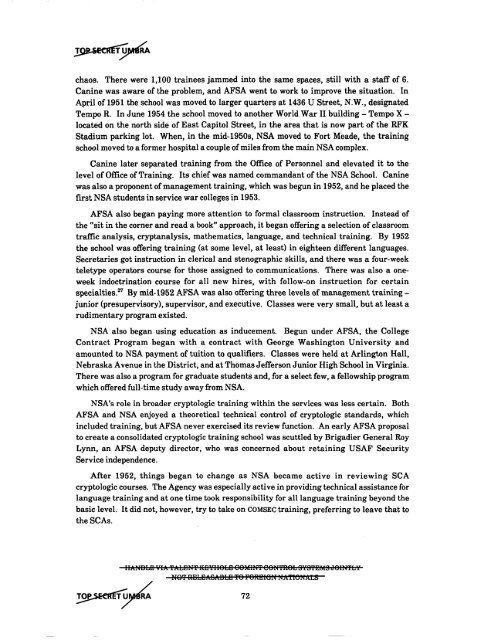American Cryptology during the Cold War - The Black Vault
American Cryptology during the Cold War - The Black Vault
American Cryptology during the Cold War - The Black Vault
Create successful ePaper yourself
Turn your PDF publications into a flip-book with our unique Google optimized e-Paper software.
chaos. <strong>The</strong>re were 1,100 trainees jammed into <strong>the</strong> same spaces, still with a staff of 6.<br />
Canine was aware of <strong>the</strong> problem, and AFSA went to work to improve <strong>the</strong> situation. In<br />
April of1951 <strong>the</strong> school was moved to larger quarters at 1436 U Street, N.W., designated<br />
Tempo R. In June 1954 <strong>the</strong> school moved to ano<strong>the</strong>r World <strong>War</strong> II building - Tempo X<br />
located on <strong>the</strong> north side of East Capitol Street, in <strong>the</strong> area that is now part of <strong>the</strong> RFK<br />
Stadium parking lot. When, in <strong>the</strong> mid-1950s, NSA moved to Fort Meade, <strong>the</strong> training<br />
school moved to a former hospital a couple ofmiles from <strong>the</strong> main NSA complex.<br />
Canine later separated training from <strong>the</strong> Office of Personnel and elevated it to <strong>the</strong><br />
level of Office of Training. Its chief was named commandant of <strong>the</strong> NSA School. Canine<br />
was also a proponent ofmanagement training, which was begun in 1952, and he placed <strong>the</strong><br />
first NSA students inservice war colleges in 1953.<br />
AFSA also began paying more attention to formal classroom instruction. Instead of<br />
<strong>the</strong> "sit in <strong>the</strong> corner and read a book" approach, it began offering a selection of classroom<br />
traffic analysis, cryptanalysis, ma<strong>the</strong>matics, language, and technical training. By 1952<br />
<strong>the</strong> school was offering training (at some level, at least) in eighteen different languages.<br />
Secretaries got instruction in clerical and stenographic skills, and <strong>the</strong>re was a four-week<br />
teletype operators course for those assigned to communications. <strong>The</strong>re was also a oneweek<br />
indoctrination course for all new hires, with follow-on instruction for certain<br />
specialties. 27 By mid-1952 AFSA was also offering three levels of management trainingjunior<br />
(presupervisory), supervisor, and executive. Classes were very small, but at least a<br />
rudimentary program existed.<br />
NSA also began using education as inducement. Begun under AFSA, <strong>the</strong> College<br />
Contract Program began with a contract with George Washington University and<br />
amounted to NSA payment of tuition to qualifiers. Classes were held at Arlington Hall,<br />
Nebraska Avenue in <strong>the</strong> District, and at Thomas Jefferson Junior High School in Virginia.<br />
<strong>The</strong>re was also a program for graduate students and, for a select few, a fellowship program<br />
which offered full-time study away from NSA.<br />
NSA's role in broader cryptologic training within <strong>the</strong> services was less certain. Both<br />
AFSA and NSA enjoyed a <strong>the</strong>oretical technical control of cryptologic standards, which<br />
included training, but AFSA never exercised its review function. An early AFSA proposal<br />
to create a consolidated cryptologic training school was scuttled by Brigadier General Roy<br />
Lynn, an AFSA deputy director, who was concerned about retaining USAF Security<br />
Service independence.<br />
After 1952, things began to change as NSA became active in reviewing SCA<br />
cryptologic courses. <strong>The</strong> Agency was especially active in providing technical assistance for<br />
language training and at one time took responsibility for all language training beyond <strong>the</strong><br />
basic level. It did not, however, try to take on COMSEC training, preferring to leave that to<br />
<strong>the</strong>SCAs.<br />
IIAUBbB YIA TAbBUT HiBYIISbB 8SMlfff 8SUTR8b S"{S'fBMSd'8mTLY<br />
PlS'F R8108/tB*BbtJ 'Fe FeRtJlffl{ N*Tlfiflf1tLS<br />
72
















